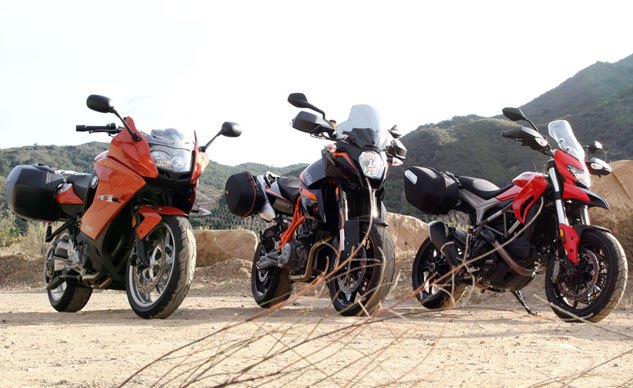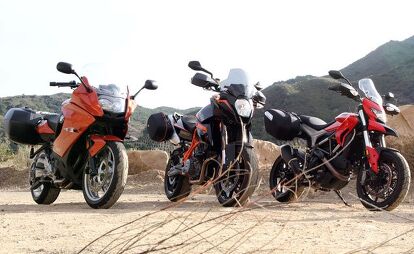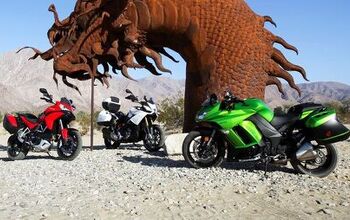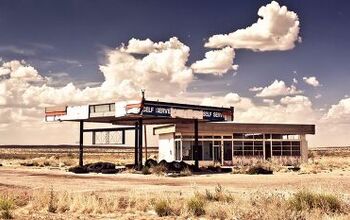2013 Middleweight Sport-Touring Shootout – Video
BMW F800GT vs. Ducati Hyperstrada vs. KTM 990 SM-T
You may look at these three bikes and think to yourself this is a no-brainer, the Beemer easily bests the other two for sport-touring honors. That’s what we concluded from our riding impressions and reported in the accompanying video. But then we returned to the MO offices, filled-in the blanks of the ScoreCard and, to our surprise, the most sport-touringest bike of this group nearly lost.
How can this be? Well, there’s no way to sugarcoat the fact that the F800GT executes its duties in a markedly underwhelming fashion. And because of this lackluster performance the KTM and Ducati were able to score close to the Beemer in sport-touring categories while largely outscoring the GT in the non-sport-touring categories. The accumulated results blindsided the apparent victor.
First up, in the heavily weighted engine performance category, the 78.4 horsepower of BMW’s parallel-Twin was crushed by the two V-Twins. The Ducati’s 11° Testastretta engine managed to output 18 more peak horses than the BMW from just 23 more cubic centimeters, and the Duc is only nine horses down on the KTM’s Twin with 178cc greater capacity.
“The Ducati is my hands-down pick for best engine, both in outright performance and also because of its chameleon-like character thanks to the different engine modes,” says guest tester and sister site ( DirtBikes.com) editor, Scott Rousseau.
2013 Ducati Hyperstrada Review
“The F800 engine proves to be incredibly effective. It exhibits strong low-end pull despite its smallest displacement,” says Chief Editor, Kevin Duke. “But while the Beemer’s engine is effective, it’s simply not as pleasing as the V-Twins in this group.”
But, as the saying goes, there’s no replacement for displacement, and KTM’s 999cc Twin, while long in tooth and devoid of modern electronic aids, managed to outscore the others in the engine performance category: 95% to 85% compared to the Duc, while the BMW garnered only 72%.
“The KTM certainly uses its displacement advantage to lunge forward from low revs with total authority,” says Rousseau. “Its EFI is crisp without being abrupt, and it delivers such broad power that I often found myself leaving the transmission in third gear while in the twisties and letting the Katoom’s wonderfully electric torque take up the slack.”
“Relative to the others in this group, the KTM motor is the clear powerhouse, boasting a bountiful midrange that the smaller engines can’t match,” says Duke. “Timid riders won’t like the SM-T’s aggressive throttle response – and there are no softer ride modes to switch to – but experienced riders will enjoy its snappy reactions.”
Surprisingly, it wasn’t the big-cube KTM motor that emerged champion in roll-on contests. That honor went to the surprisingly punchy Ducati V-Twin edging its bigger rival. To calm highway vibration, KTM appears to have fitted the SM-T with tall gearing which reduces its roll-on thrust.
The GT’s handling manners surprised everyone with a lighter front feel than expected and ample cornering clearance.
“BMW’s chassis was designed for the task at hand, and its straight-line stability is unmatched by the competition here. In the tight stuff, I found the F800’s handling to be precise and predictable,” says Rousseau.
Although impressive, the GT still fell a little short of the other two competitors in the Handling category, scoring an 80% compared to the 83% and 85% of the KTM and Ducati, respectively. The Ducati’s handling prowess is downright impressive, while the KTM exemplifies neutral steering and effortlessly drops into corners.
“Relative to the others, the Hyper is twitchy at highway speeds,” says Duke. “Minimal weight on the front end and its light throttle spring makes the Hyper feel busy on the freeway.”
“It may be a bit of stretch to call the Hyperstrada ‘twitchy’ but it’s definitely not as planted as the BMW or the KTM,” retorts Rousseau. “I’ve long been a fan of KTM’s streetbikes, and their excellent handling is part of the reason. For sure, it doesn’t match the Ducati’s steering quickness, but it still delivers sharp handling without feeling twitchy or nervous in a straight line.”
The higher footpegs helping the BMW attain its severe cornering angles, however, diminished some of its long-distance comfort by reducing the seat-to-peg distance. It only scored an 85% to the KTM’s 82% in the Ergonomics/Comfort category – a category the BMW should have ruled with authority. Yes, it has better fairing protection, but the KTM’s roomy rider triangle was preferable among our testers. Smaller or less-experienced riders might prefer something less rangy like the Beemer.
“Although the SM-T slots into this group by virtue of its intention and price point, it feels like a larger-class motorcycle than the others,” Duke remarks. “The KTM isn’t the right choice for those looking for a sport-tourer that feels small and nimble.”
The only two categories the GT dominated were the Luggage/Storage and Transmission/Clutch categories, scoring a perfect 100% in both. The GT’s panniers are the only lockable, hard-shell bags of the group and boast a clever shelf that discourages cargo from tumbling onto the pavement when the bags are opened.
KTM’s small saddlebags hurt its luggage capacity, and there are no provisions to lock their entries or secure them to the bike. The Duc’s bags are large enough to hold more than two-day’s worth of clothing and can be locked to their hangers.
Fuel Economy and Range
| Tank Capacity | Average MPG | Fuel Range | |
|---|---|---|---|
| BMW F800GT | 4.0 gal. | 50 | 200 mi. |
| Ducati Hyperstrada | 4.2 gal. | 43 | 181 mi. |
| KTM 990 SM-T | 5.0 gal. | 34 | 170 mi. |
The problem with BMW’s sport-tourer is that luggage is not included in its MSRP. It has to be purchased as an accessory at a cost of $413 per pannier, raising the price of the GT to $14,016 and making it the most expensive bike of the three.
BMW advertising touts the fact that the base model GT retails for the same price as the model it’s replacing, last year’s ST. But, as Hipster Editor, Jon Langston, wrote in his initial review of the GT; “A North American buyer can certainly get a stripped F800GT for the same MSRP as the outgoing ST, but that buyer will have to order the bike from his local dealer and then wait for delivery from Germany. About six weeks.”
In regards to the transmission/clutch, the BMW’s worked effortlessly with the KTM a close second. It was the Hyper’s transmission falling well short of the standards set by the others in this trio. “It takes greater effort to kick into the next gear, and shifts are less than positive,” reports Duke. “Also, I’m not the only one who found a false neutral between gears.”
The GT boasts BMW’s Electronic Suspension Adjustment, potentially boosting its Technology score, but this particular version only adjusts rebound damping on the shock, not the fork, with no compression adjustment at either end. As much as we like BMW’s ESA offerings on other models in its line-up, we found the cheap-man’s version not worth the price of admission.
While the Hyperstrada’s suspension allowed a bit too much pitching movement when braking, the SM-T’s setup was just about ideal.
“The KTM’s suspension is my favorite of the bunch,” Duke affirms. “It does the rare trick of offering good control while also being nicely compliant – Botts dots all but disappear beneath its wheels. The factory setup is pretty much perfect, but there’s a full range of adjusters the others lack that can be fine-tuned to rider preference.”
While we appreciate the GT’s maintenance-free belt drive, we weren’t as thrilled about the buzz felt through the handlebars at speeds above 65 mph, nor do we like the long-turn throttle requiring a nearly double-jointed wrist to reach the throttle stop.
And that’s how, at least on paper, a more sport-touring motorcycle can almost lose a shootout to two lesser-equipped motard-tourers. The final tally has the BMW F800GT in first with 82% of the overall vote, the SM-T in second with 81% and the Ducati Hyperstrada a close third with an overall scoring of 80%.
Individual Tester Scorecard
| Kevin | Tom | Scott | Total | |
|---|---|---|---|---|
| BMW F800GT | 80% | 82% | 82% | 82% |
| Ducati Hyperstrada | 79% | 82% | 79% | 80% |
| KTM 990 SM-T | 81% | 83% | 78% | 81% |
“By almost every measure, BMW’s F800GT is the most fully realized sport-touring machine here, boasting the most effective wind protection, superior luggage and exemplary handling,” says Duke. “However, it disappoints by its limited legroom and an underpowered parallel-Twin motor that lacks charisma and transmits oodles of vibrations.”
As for the Hypermotard, Ducati asserts that it wasn’t intended to be a sport-touring machine, and that was proved during our shootout. “It’s a riotously effective sportbike/commuter,” Duke observes, “but it’s too narrowly focused to have the broad range of capabilities that a sport-touring bike should have.”
When all was said and done, all three editors shared warmest feelings for the KTM. “Climb aboard the SM-T and its upright seating position, flat, well-padded seat and wide handlebar make for a wonderful cockpit, and I’d have no trouble riding the KTM from one end of the country to the other,” says Rousseau.
To which Duke agrees. “Of this trio, the SM-T most appeals to my sensibilities. I dig its cool, rough-and-ready countenance, and the punchiness of its motor stands above the others. To me, it’s worth the $700 premium over the Hyperstrada even if its saddlebags aren’t quite adequate in size or security. There’s ample room to strap on a large tail bag.”
Middleweight Sport-Tourers Specs
| BMW F800GT | Ducati Hyperstrada | KTM 990 SM-T | |
|---|---|---|---|
| MSRP | $14,016 | $13,295 | $13,999 |
| Horsepower | 78.4 @ 8300 rpm | 96.6 @ 9500 rpm | 105.3 @ 9300 rpm |
| Torque | 54.4 ft-lb. @ 6100 rpm | 58.7 ft-lb. @ 7700 rpm | 66.1 ft-lb. @ 7300 rpm |
| Engine Capacity | 798 cc | 821 cc | 999 cc |
| Engine Type | DOHC, liquid-cooled parallel Twin, dry sump | Testastretta, liquid-cooled, 11° V-Twin | Liquid-cooled, 75° V-Twin |
| Bore x Stroke | 82 x 75.6 mm | 88 x 67.5 mm | 101 x 62.4 mm |
| Compression | 12.0 :1 | 12.8 :1 | 11.5 :1 |
| Fuel System | EFI | EFI | EFI |
| Transmission | 6-speed | 6-speed | 6-speed |
| Clutch | Wet, multi-plate | Wet, multi-plate with slipper function | Wet, multi-plate |
| Final Drive | Belt | Chain | Chain |
| Frame | Cast aluminum | Tubular steel trellis | Chrome molybdenum steel lattice |
| Front Suspension | 43mm telescopic fork | 43mm inverted telescopic fork | 48mm inverted telescopic fork |
| Rear Suspension | Cast aluminum single-sided swingarm with eccentric adjustment for rear axle, central spring strut, hydraulically adjustable spring preload via handwheel | Cast aluminum single-sided swing arm with eccentric adjustment for rear axle, central spring strut, spring preload hydraulically adjustable via handwheel | WP-Monoshock, electrically controlled rebound damping, spring preload hydraulically adjustable via handwheel |
| Front Brakes | Twin fixed calipers, 320mm discs | Twin radial-mount 4-piston Monobloc Brembo calipers, 320mm semi-floating discs | Twin Brembo 4-piston fixed-caliper, radial-mount, 305mm discs |
| Rear Brakes | Single 265mm disc, single-piston floating caliper | Single 245mm disc, 2-piston caliper, ABS 9MP as standard | Single 240mm disc, Brembo 2-piston floating caliper |
| Front Tire | 120/70-17 | 120/70-17 | 120/70-17 |
| Rear Tire | 180/55-17 | 180/55-17 | 180/55-17 |
| Seat Height | 31.5” | 33.5 – 32.7” | 33.7” |
| Wheelbase | 59.6” | 59.1” | 59.4” |
| Curb Weight | 470 lbs | 450 lbs | 465 lbs |
| Fuel Capacity | 4.0 gal | 4.2 gal | 5.0 gal |
A former Motorcycle.com staffer who has gone on to greener pastures, Tom Roderick still can't get the motorcycle bug out of his system. And honestly, we still miss having him around. Tom is now a regular freelance writer and tester for Motorcycle.com when his schedule allows, and his experience, riding ability, writing talent, and quick wit are still a joy to have – even if we don't get to experience it as much as we used to.
More by Tom Roderick











































Comments
Join the conversation
I took my Hyperstrada for a 5 day, 2000 mile tour through twisties in WA,OR, and ID last September and had a riot on it. I'd put about 150,000 miles on 2 ST2's in the previous 12 years and I'd say that I found the HS just as comfortable and more fun to ride...but then i'm a Ducati guy. Mind you, I'm not a big guy, 5'9" and 160 lb. And the 821 mill is just too much fun, especially in sport mode. The fueling on mine is fine and I have no flat spots or glitches(maybe I'm just lucky!).
I've been getting 52 MPG on my Hyperstrada, freeway and twisties, around town not so much. I've had many bikes and was tired of maintenance, insurance and DMV fees that come with having multiple bikes, I decided to live with just one, I got the Hyperstrada because I can take the bags and windshield off for short commutes and fun without having a big ol' bike, it'll do for a tourer, I rode 190 miles the other day and only stopped for ten minutes, wasn't that bad. It's kind of like having a Honda XR650L with 100 horsepower :-)